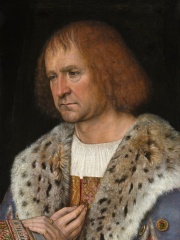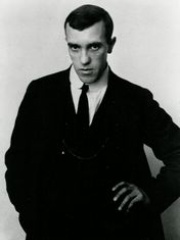





The Most Famous
PAINTERS from Estonia
Top 7
The following people are considered by Pantheon to be the most legendary Estonian Painters of all time. This list of famous Estonian Painters is sorted by HPI (Historical Popularity Index), a metric that aggregates information on a biography's online popularity.

1. Michael Sittow (1459 - 1525)
With an HPI of 64.43, Michael Sittow is the most famous Estonian Painter. His biography has been translated into 26 different languages on wikipedia.
Michael Sittow (c. 1469 – 1525), also known as Master Michiel, Michel Sittow, Michiel, Miguel, and several other variants, was a painter from Reval (Tallinn), now capital of Estonia, who was trained in the tradition of Early Netherlandish painting. For most of his life, Sittow worked as a court portrait painter, for Isabella of Castile and her Habsburg relatives in Spain and the Netherlands, and other prominent royal houses. He is considered one of the most important Netherlandish painters of the era.

2. Eugen Dücker (1841 - 1916)
With an HPI of 60.07, Eugen Dücker is the 2nd most famous Estonian Painter. His biography has been translated into 18 different languages.
Eugen Gustav Dücker (German pronunciation: [ˈɔʏɡeːn ˈɡʊstaːf ˈdʏkɐ, ˈɔʏɡn̩ -]; 10 February [O.S. 29 January] 1841 – 6 December 1916) was a German landscape painter, born a Russian Imperial subject on Saaremaa (then Governorate of Livonia, present-day Estonia), associated with the Düsseldorfer Malerschule.

3. Konrad Mägi (1878 - 1925)
With an HPI of 59.49, Konrad Mägi is the 3rd most famous Estonian Painter. His biography has been translated into 25 different languages.
Konrad Vilhelm Mägi (1 November 1878 – 15 August 1925) was an Estonian painter; one of the first modernist painters in Estonia and the Nordic countries, at the core of whose creative legacy are visionary landscapes. He only worked for sixteen years, yet the total volume of his oeuvre is estimated to be around 400 paintings. Numerous exhibitions of his works have been held in Estonia, and in recent years, his art has been discovered in Europe: in 2017, there was a solo exhibition of Konrad Mägi's paintings in the Galleria Nazionale d'Arte Moderna in Rome; in 2018, his works were displayed at the exhibition Wild Souls: Symbolism in the Art Of the Baltic States in the Orsay Museum; in 2021, more than a hundred of Mägi's works were exhibited in the EMMA Museum in Espoo, and in 2022, the same works were displayed in the Lillehammer Art Museum. Konrad Mägi's works are particularly appreciated for their vigorous and impulsive colours and a pantheistic approach to nature, making him unique in European early-20th-century modernism. Mägi worked in different parts of Europe, according to which his oeuvre is divided into rather dissimilar chapters: Denmark, Norway, France, the island of Saaremaa, southern Estonia, Italy, etc. The reception of his art went through various periods, too. In the 1920s and 1930s, Konrad Mägi's oeuvre influenced a large part of Estonian art created at the time. During World War II, his art was condemned (the Soviet authorities ordered his works to be removed from exhibitions, his letters to be destroyed, etc.); it continued to be forbidden until the second half of the 1950s. Towards the end of the 1950s, as political austerity relaxed, Mägi's oeuvre was "reintroduced" and several retrospectives were held. Despite the fact that Mägi spent the majority of his life in towns, his oeuvre mainly revolves around landscapes: environments lacking humans, where nature offers irrational, mystical, metaphysical and religious experiences. Konrad Mägi's oeuvre is rooted in existential tensions that made him yearn for other potential worlds. As a young man he took actively part in the revolutionary movement, but later withdrew completely from politics and focussed entirely on art. “Happiness is not for us, sons of a poor land,” Mägi once wrote. “For us, art is the only way out, because when the soul is filled with the eternal suffering of life, art will provide what life cannot give us. There, in art, in one's own oeuvre, can one find peace.” In addition to landscape paintings, Mägi painted portraits (including several portraits of members of the women's movement) and still-lifes. He was the first director of Pallas, the first Estonian higher art school. Konrad Mägi’s health seriously troubled him throughout his creative career: various illnesses led to a rapid deterioration of his health in the 1920s. Konrad Mägi was only 46 years old when he died. The whereabouts of more than half of his works are still unknown.

4. Johann Köler (1826 - 1899)
With an HPI of 58.83, Johann Köler is the 4th most famous Estonian Painter. His biography has been translated into 21 different languages.
Johann Köler (8 March 1826 – 22 April 1899) was a leader of the Estonian national awakening and a painter. He is considered as the first professional painter of the emerging nation. He distinguished himself primarily by his portraiture and to a lesser extent by his landscape paintings. Some of his most notable pictures depict the Estonian rural life in the second half of the 19th century.

5. Amandus Adamson (1855 - 1929)
With an HPI of 58.48, Amandus Adamson is the 5th most famous Estonian Painter. His biography has been translated into 18 different languages.
Amandus Heinrich Adamson (12 November 1855 near Paldiski, Governorate of Estonia, Russian Empire – 26 June 1929 in Paldiski, Estonia) was an Estonian sculptor and painter.

6. Ants Laikmaa (1866 - 1942)
With an HPI of 58.47, Ants Laikmaa is the 6th most famous Estonian Painter. His biography has been translated into 22 different languages.
Ants Laikmaa (5 May 1866, Araste – 19 November 1942, Kadarpiku) was an Estonian painter.

7. Paul Raud (1865 - 1930)
With an HPI of 55.64, Paul Raud is the 7th most famous Estonian Painter. His biography has been translated into 16 different languages.
Paul Raud (22 October [O.S. 10 October] 1865 in Kirikuküla, Viru-Jaagupi Parish – 22 November 1930 in Tallinn) was an Estonian painter.
People
Pantheon has 7 people classified as Estonian painters born between 1459 and 1878. Of these 7, none of them are still alive today. The most famous deceased Estonian painters include Michael Sittow, Eugen Dücker, and Konrad Mägi.
Deceased Estonian Painters
Go to all RankingsMichael Sittow
1459 - 1525
HPI: 64.43
Eugen Dücker
1841 - 1916
HPI: 60.07
Konrad Mägi
1878 - 1925
HPI: 59.49
Johann Köler
1826 - 1899
HPI: 58.83
Amandus Adamson
1855 - 1929
HPI: 58.48
Ants Laikmaa
1866 - 1942
HPI: 58.47
Paul Raud
1865 - 1930
HPI: 55.64
Overlapping Lives
Which Painters were alive at the same time? This visualization shows the lifespans of the 6 most globally memorable Painters since 1700.

